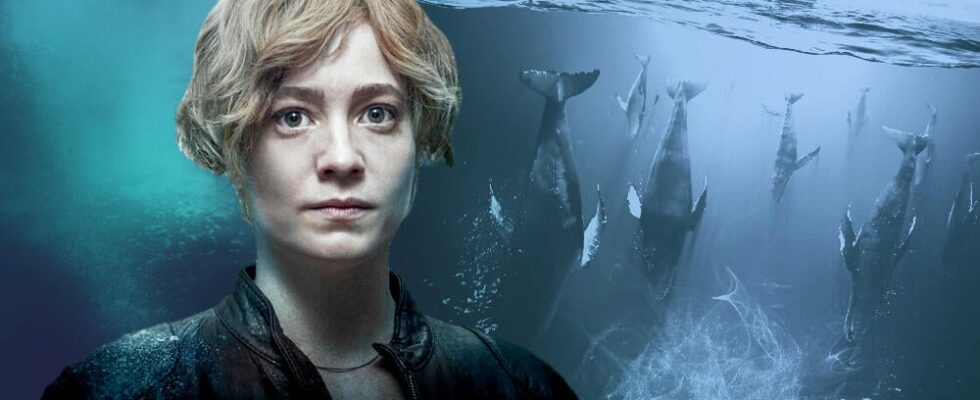In the ZDF event series Der Schwarm, sea creatures around the world turn against humans. Crabs overrun beaches and lobsters spark a pandemic. But what makes the most impression are the otherwise peaceful colossuses of the oceans: whales.
First we see how they attack a tourist boat and a friend of the main character Leon Anawak (Joshua Odjick) is killed. In the 3rd episode of the series we get to know a different side of them: Leon dives down to the mammals sleeping hanging vertically in the sea. Moviepilot is not (yet) NationalGeographicPilot, but at this point we will clarify two important questions that Der Swarm raises:
Yes, some whales do sleep in a way similar to The Swarm
Whales are mammals, so they need to come to the surface regularly to get oxygen through their blowhole. So how do they sleep in the water without drowning?
ZDF
The whales are sleeping in The Swarm
The answer is: Whales sleep, but not like humans. They don’t breathe autonomously like humans do. When we are completely unconscious, we still breathe. It’s different with whales. Researcher Naomi Rose explained this to Newsweek last year:
They don’t breathe autonomously like animals do on land. Would you […] properly sleeping, i.e. being unconscious, they would not breathe and drown. So have [Wale] solved this problem with the one-sided sleep: that is, they only shut down one half of their brain at a time while the other remains conscious and breathing.
Strictly speaking, it is more about resting than sleeping. Sperm whales sleep as seen in The Swarm. They hang vertically in groups in the water. This lasts about an hour before they need to catch their breath again. According to Newsweek, however, not all whale species rest like this. Others, for example, float lifeless on the surface of the water.
Are whales dangerous to humans?
The next question that The Swarm opens up is: Can whales really attack humans? Here we have to differentiate.
Basically, whales are not considered dangerous, quite the opposite. While the animals can approach tourist boats, they typically only do so to satisfy their curiosity (via Whale Facts). A situation like in The Swarm (without a swarm) is therefore unlikely.
However, there are still individual reports of attacks by the sea giants. On the one hand, this goes back to the real case of the whaling ship Essex, which was attacked and sunk by a sperm whale in 1820. This story inspired Herman Melville’s novel Moby Dick and formed the basis of the Chris Hemsworth film In the Heart of the Sea. However, this is a case of extreme rarity.
ZDF
A whale sinks a boat in The Swarm
Most reports of attacks on humans concern killer whales, also known as orcas or killer whales. Orcas are counted among the dolphins (which in turn belong to the species of whales). They feed on fish, seals and the like. However, in the list of orca attacks (at Wikipedia) there is only one well-documented case in which a wild killer whale bit a human. That was in 1972.
Attacks by killer whales living in captivity are more notorious. Four deaths are attributed to attacks by orcas in captivity. If you want to know more about this, you can watch the documentary Blackfish, which deals with the living conditions of killer whales in theme parks like SeaWorld. This happens with the example of the animal Tilikum, to which three deadly attacks on humans are attributed. Blackfish can be streamed in Germany on Netflix, among others.
More articles on The Swarm:
Very rare and bizarre: When a whale swallows a diver
Most encounters between wild whales and humans, on the other hand, sound cute or whimsical. For example, in 2018, news broke that a humpback whale saved a woman’s life by protecting her from a tiger shark (via LiveScience ).
Three years later, a diver reported being accidentally swallowed by a humpback whale. According to the Cape Cod Times, Michael Packard described it this way:
I was completely inside, it was completely black. I just thought, ‘It’s impossible to get out of here. I am through. I’m dead.’
After a few seconds, however, Packard saw the light. The whale tilted its head to one side and the diver found himself free. He was unharmed.
